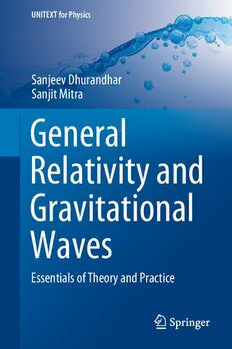Table Of ContentUNITEXT for Physics
Sanjeev Dhurandhar
Sanjit Mitra
General
Relativity and
Gravitational
Waves
Essentials of Theory and Practice
UNITEXT for Physics
SeriesEditors
MicheleCini,UniversityofRomeTorVergata,Roma,Italy
AttilioFerrari,UniversityofTurin,Turin,Italy
StefanoForte,UniversityofMilan,Milan,Italy
GuidoMontagna,UniversityofPavia,Pavia,Italy
OresteNicrosini,UniversityofPavia,Pavia,Italy
LucaPeliti,UniversityofNapoli,Naples,Italy
AlbertoRotondi,Pavia,Italy
PaoloBiscari,PolitecnicodiMilano,Milan,Italy
NicolaManini,UniversityofMilan,Milan,Italy
MortenHjorth-Jensen,UniversityofOslo,Oslo,Norway
UNITEXT for Physics series publishes textbooks in physics and astronomy, char-
acterized by a didactic style and comprehensiveness. The books are addressed to
upper-undergraduateandgraduatestudents,butalsotoscientistsandresearchersas
importantresourcesfortheireducation,knowledge,andteaching.
Moreinformationaboutthisseriesathttps://link.springer.com/bookseries/13351
·
Sanjeev Dhurandhar Sanjit Mitra
General Relativity
and Gravitational Waves
Essentials of Theory and Practice
SanjeevDhurandhar SanjitMitra
Inter-UniversityCentreforAstronomy Inter-UniversityCentreforAstronomy
andAstrophysics(IUCAA) andAstrophysics(IUCAA)
Pune,Maharashtra,India Pune,Maharashtra,India
ISSN2198-7882 ISSN2198-7890 (electronic)
UNITEXTforPhysics
ISBN978-3-030-92334-1 ISBN978-3-030-92335-8 (eBook)
https://doi.org/10.1007/978-3-030-92335-8
©TheEditor(s)(ifapplicable)andTheAuthor(s),underexclusivelicensetoSpringerNature
SwitzerlandAG2022
Thisworkissubjecttocopyright.AllrightsaresolelyandexclusivelylicensedbythePublisher,whether
thewholeorpartofthematerialisconcerned,specificallytherightsoftranslation,reprinting,reuse
ofillustrations,recitation,broadcasting,reproductiononmicrofilmsorinanyotherphysicalway,and
transmissionorinformationstorageandretrieval,electronicadaptation,computersoftware,orbysimilar
ordissimilarmethodologynowknownorhereafterdeveloped.
Theuseofgeneraldescriptivenames,registerednames,trademarks,servicemarks,etc.inthispublication
doesnotimply,evenintheabsenceofaspecificstatement,thatsuchnamesareexemptfromtherelevant
protectivelawsandregulationsandthereforefreeforgeneraluse.
Thepublisher,theauthorsandtheeditorsaresafetoassumethattheadviceandinformationinthisbook
arebelievedtobetrueandaccurateatthedateofpublication.Neitherthepublishernortheauthorsor
theeditorsgiveawarranty,expressedorimplied,withrespecttothematerialcontainedhereinorforany
errorsoromissionsthatmayhavebeenmade.Thepublisherremainsneutralwithregardtojurisdictional
claimsinpublishedmapsandinstitutionalaffiliations.
ThisSpringerimprintispublishedbytheregisteredcompanySpringerNatureSwitzerlandAG
Theregisteredcompanyaddressis:Gewerbestrasse11,6330Cham,Switzerland
Iliketheauthors’styleandthechoiceof
topics.Theyhavetakenanunusualapproach
sothatthereadergetstoseehowrelativity
worksinpracticalsituations. Normallyatext
inrelativitypresentsthesubjectasan
abstractmathematicalexercise.Theauthors
haveworkedoutexampleswhereinthereader
appreciateshowthetheoryworks.
JayantNarlikar
Tomyparents(especiallymymother)and
BhalchandraDhurandhar(myfather’suncle)
whoindulgedmychildhoodscientificantics.
—SanjeevDhurandhar
Tomyparentsandmyuncle,whodidtheir
bestformyeducation.
—Sanjit Mitra
Preface
Several high-quality textbooks at various levels have been published on General
Relativity(GR).Thenwhy,onemayask,writeanotherbook?Therearetworeasons
whywechosetowritethisbook.Thefirstreasonisthat,iftherehadbeenasingle
book available that could have served our purpose, we might not have been moti-
vated enough to write this book! A number of universities and institutions offer a
half-semestercourseonGeneralRelativitytofinalyearMasters’studentsinPhysics
oraspartofPh.D.coursework.Wehavebeenteachingsuchcoursesforyears(oreven
decades),butwecouldnotrecommendforsuchacourseasingleself-containedbook.
Wehadtorefertomultiplebooksfordifferenttopicssuchasspecialrelativity,tensor
calculus, differential geometry, black holes, etc. inevitably with different conven-
tions,notations,etc.Often,inordertodojustice,thebooksbecametoovoluminous
with interlinked concepts which were difficult to disentangle. It is not uncommon
to encounter students who have completed a course on GR without having any
insights into the rationale/prescription for parallel transport in Riemannian geom-
etry. Referring students to advanced texts has the consequence of bogging them
down and making them lose sight of the main objective of learning general rela-
tivity. We have, therefore, adopted a middle-ground, in which the contents can be
followed through smoothly without omissions. The instructor may teach a short
coursewithoutcompromisingontheessentialmathematicalconceptswhichprovide
areasonablysolidfoundation.Thisisourmainmotivationinwritingthisbook.We
expect that students will find it easy to follow the introductory topics covered and
gainvaluableinsightsfromthisbook.Moreover,aclearunderstandingofthebasics
willalsoempowerthestudentstoaskadvancedquestionsandfurtherseekanswers
fromadvancedtexts.
Theothermajormotivationistoprovideanintroductiontogravitationalwaves
(GW). With the detection of GW and given the ever-increasing sensitivity of GW
detectors,thefieldissizzling.Alargenumberofresearchershavebeenmotivatedto
enterintothisfieldtocarryoutresearchintheobservationalaspects.Againthereis
noshortintroductionreadilyavailablethatcanbeunderstoodinashorttimewithout
sacrificingcontent.Infact,fundamentalsonGWdataanalysiscanrarelybefound
in introductory books. Moreover, many of these researchers may not be familiar
ix
x Preface
with GR either, but we believe that they would appreciate the field more if they
areprovidedwithabasicintroductionnotrequiringtoomucheffort.Thisstrongly
motivated us to put significantly more emphasis on GW and make it an essential
one-stopintroductionpackageforsomeonebeginningaresearchcareerinGW.
The authors would like to thank Jayant Narlikar and Tarun Souradeep for their
encouragement.Wearegratefultoourstudentsandyoungercolleagueswithwhom
wehaveheldanimatedandspiriteddiscussionsfromwhichthebookhassignificantly
benefited.
Finally,SVDwouldliketothankNASI,India,forthePlatinumJubileeFellowship
andSMwouldliketoacknowledgeDST,India,fortheSwarnaJayantiFellowship.
Apartofthisbookwaswrittenduringbothfellowships.
Pune,India SanjeevDhurandhar
SanjitMitra
Contents
1 OverviewofSpecialRelativity ................................... 1
1.1 Introduction .............................................. 1
1.2 PostulatesofSpecialRelativity(SR) ......................... 2
1.3 Space-TimeDiagrams:APictureIsWorthaThousandWords ... 4
1.3.1 SettingUptheAxesforaMovingObserver ............ 6
1.3.2 LorentzContractionandTimeDilation ................ 9
1.4 LorentzTransformations ................................... 11
1.4.1 TheLorentzTransformationEquations ................ 11
1.4.2 VelocityAddition .................................. 13
1.5 Four-VectorNotationandCovariantFormalism ................ 14
1.6 RelativisticMechanics ..................................... 16
1.7 CovariantFormulationofElectrodynamics .................... 19
2 TheEquivalencePrinciple ...................................... 27
2.1 EquivalencePrinciple:WeakForm ........................... 28
2.2 EquivalencePrinciple:StrongForm(SEP) .................... 30
2.3 GravityandCurvatureofSpace-Time ........................ 30
2.3.1 GravityBendsLightRays ........................... 31
2.3.2 GravityAffectsClocks:GravitationalRedshift ......... 32
3 TensorAlgebra ................................................ 37
3.1 Introduction .............................................. 37
3.2 BasisVectors ............................................. 39
3.3 ContravariantandCovariantComponentsofaVector ........... 41
3.3.1 TheJacobianmatrices .............................. 43
3.4 TheMetric ............................................... 44
3.4.1 ScalarProduct ..................................... 44
3.4.2 RaisingandLoweringofIndices ..................... 45
3.5 TensorsofHigherRank .................................... 45
3.5.1 TransformationLaws ............................... 45
3.5.2 SymmetricandAnti-symmetricTensors ............... 47
xi

